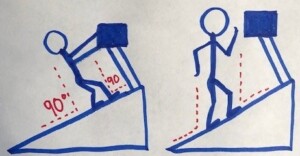
Walking can be blistering cardio exercise or it can be useless; it all depends on what you make of it.
Just because we learn to walk at around the age of 11 months, give or take, doesn’t mean that walking can’t be an excellent form of cardio exercise.
Type of Walking that Doesn’t Count As Cardio Exercise
As a former personal trainer for a large gym, which had tons of treadmills, my biggest peeve was the prevalence of people holding onto the treadmill while walking.
Every day I went up to a few of these patrons and talked to them about this. The responses I got from some of them still astound me to this day. But that’s a whole different article.
Right now, I just want to explain the ways to make walking count as actual cardio exercise, and holding onto the treadmill is not one of them.
When you walk in day to day life, technically, this is aerobic activity. If you define “exercise” as any movement, then walking from one room in the house to the other is aerobic activity.
But “house walking” will not produce a training effect. But it sure beats walking at the same speed on a treadmill while holding on, because holding on downgrades you; it puts you below your baseline.
This is why the people who hold onto the treadmill are usually the ones who, after months on end of doing this and no strength training, still haven’t lost weight.
When is walking actual cardio exercise?
When your form is the way nature intended it while on a treadmill: hands free, and preferably, arms moving naturally in synch with your lower body.
The second prerequisite is heart rate elevation. If your heart rate is elevated, there will be a training effect on your cardiovascular system.
The more that the heart rate is elevated, the more training effect will occur.
Just because walking on a level course at a casual pace is easy, doesn’t mean that you can’t convert this basic human movement into a strenuous, intense workout.

Shutterstock/Microgen
How to Make Walking Count As Actual Cardio Exercise
Ever walk briskly up a hill? There you go. Find a short hill and walk as fast as you can to the top. You’ll be panting at the top.
If the hill is long, go slower, and take note of your heart rate and faster, deeper breathing. Yes, this is exercise alright.
You can pretty much duplicate this on a treadmill—but only if you keep your hands off the rails, the bar or the console.
If you’re walking hills or inclined streets outside, why would you hold onto something just because you’re inside? Makes zero sense.
Holding on at an incline cancels out the incline. Check out the diagram below and you’ll clearly see why. The figure who’s holding on is tilted back at the same angle as the incline!

Incorrect vs. correct incline walking on a treadmill
If he forces himself into a vertical position (like the figure on the left) while still holding on, this would not fix the problem, because in order to maintain a vertical position while holding on, you’d have to maintain a tugging and gripping with your hands and arms—which translates to as much make-believe walking as the tilting back!
So let go! If you start falling off, the speed is too fast. Adjust it, or lower the incline.
Now resume, swinging your arms, and you’ll be breathing heavily in no time. If this isn’t exercise, I don’t know what is.
For those more fit, set the incline at 15 percent and the speed at four mph, and hands off, see for how long you can walk at this setting. Alternate between this and an easier recovery pace.
Another way you can make walking actual cardio exercise is to hold light dumbbells or small weight plates and walk briskly (or at what would be a challenging pace for your fitness level) at the local park.
 Lorra Garrick is a former personal trainer certified through the American Council on Exercise. At Bally Total Fitness she trained women and men of all ages for fat loss, muscle building, fitness and improved health.
Lorra Garrick is a former personal trainer certified through the American Council on Exercise. At Bally Total Fitness she trained women and men of all ages for fat loss, muscle building, fitness and improved health.
.


























